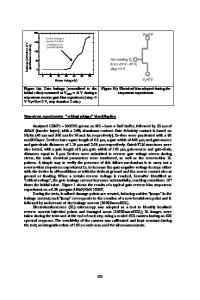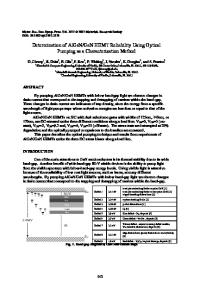A Comprehensive Approach to HEMT Reliability Testing
- PDF / 242,912 Bytes
- 7 Pages / 612 x 792 pts (letter) Page_size
- 78 Downloads / 376 Views
1195-B05-03
A Comprehensive Approach to HEMT Reliability Testing David Cheney 1, Brent Gila2, Erica Douglas2, Fan Ren3, and Steve Pearton 2 1 Electrical & Computing Engineering University of Florida, Gainesville, FL 32611, 2 Material Science & Engineering, University of Florida, Gainesville, FL 32611, 3 Chemical Engineering, University of Florida, Gainesville, FL 32611 ABSTRACT Reliability testing often manifests device weaknesses and failure mechanisms. As new materials and structures are developed, creative and different testing is often necessary to determine reliability. We are developing an in-house reliability test system that will provide the necessary testing flexibility of HEMT devices so researchers can pinpoint defects and vulnerabilities. Using commercial off-the-shelf (COTS) power supplies and data acquisition equipment, a custom control system allows for many different tests: DC and RF, temperature, step/stress/recovery, high-speed pulse, and optical pumping, as well as combinations and automated sequencing of these tests. This flexibility allows for the creation of new test types as failure mechanisms are understood. The initial station will provide for the simultaneous, independent testing of 16 devices. This paper outlines the system design and capabilities, the motivation for the system, and some results from different tests. INTRODUCTION Although silicon structures have dominated electronic devices, other materials have proven to out-perform silicon in applications where silicon is limited [1]. Because of the popularity of silicon over the past 40 years, its reliability and testing are well understood. This is not necessarily true in the realm of compound semiconductors. New failure mechanisms and vulnerabilities have presented themselves, which require researchers to explore different ways of testing to expose what is not yet known [2, 3, 4]. New testing requires flexibility and control to allow pinpointing the stress to a particular component, e. g., a contact or the gate. MOTIVATION A turnkey reliability system provided by a commercial vendor offers many advantages and disadvantages over an in-house system. Table 1 illustrates a comparison. Since the turnkey system is a finished product, it can be up and running soon after the purchase is complete; the user would have access to all available test types and features. The design of the in-house system is on-going and may never be completed as new features and test types are introduced; users have to specify and wait until a test function is designed and implemented. The turnkey system is designed from a complete set of specifications by a team of engineers who have specialized in this area. The in-house system begins with a general specification and evolves as new testing is understood and developed. Often times, expertise is drawn from many different sources, often from outside the design team.
Commercial vendors market their designs to the industry that use their systems to determine specifications, such as the life of a part. When researchi
Data Loading...











